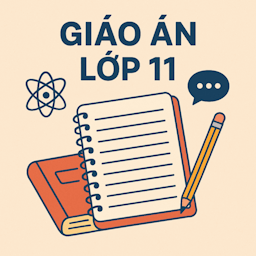Giáo án tiếng Anh lớp 11 Tuần 1 sách mới
Giáo án tiếng Anh lớp 11 chương trình mới Tuần 1
Nằm trong tài liệu Giáo án môn Tiếng Anh 11 theo tuần, giáo án Tiếng Anh 11 sách mới Tuần 1 dưới đây do VnDoc.com sưu tầm và đăng tải. Nội dung giáo án được ghi ngắn gọn theo trình tự thực tế sẽ diễn ra trong giờ lên lớp giúp giáo viên chuẩn bị đứng lớp hiệu quả.
Period 1:
INTRODUCTION
I. Objectives
By the end of the lesson, students will be able to:
- get an overview of the English book grade 11 in general: themes, units
- know about tests: oral test, fifteen - minute tests, periodical tests, first term test
- have a sense of responsibility toward learning the subject
II. Teaching method: Communicative
III. Teaching aids
- CDs & CD player, board, chalks, textbook and notebook.
III. Procedure
1. Class organization:
|
Date |
Period |
Class |
Attendance |
Absentees/Notes |
|
….. __ / __ / __ |
|
|
…. / …. |
|
2. Previous lesson check: No
3. New lesson:
|
T’s and Ss’Activities |
Knowledge |
|
Warm-up * Game: Lucky Number -T divides the whole class into two groups and plays the game. - The leader of each group chooses a number for their own group and does the following requirement in each question. If the answer is correct, they will get 10 marks. - T leads Ss in the lesson.
I. Topics and units: - Ask Ss to look through the book then tell class how many units it has. - Introduce some more information about the topics. (Including five topics in each term) - There are 8 periods in each unit. They are Getting Started, Language, Reading, Speaking, Listening, Writing, Culture and communication and Looking Back II. Tests: III. Requirements for study preparation - Each S has books (student book and work book), CDs and notebook. - Prepare for the lesson before class. -Listen to the teacher attentively and take part in the lesson actively and creatively. - Take part in the activities that the teacher requires such as pair work, group work… - Do all exercises at home, learn new words and structures
|
1. Lucky Number 2. How many girls are there in your class? 3. Do you know what your English teacher’s name is? 4. Lucky Number 5. What do you prepare for this semester? 6. Do you like studying English? Why or Why not? 7. How do you learn English well? 8. Do you speak English fluently?
1. The generation gap 2. Relationships 3. Becoming independent 4. Caring for those in need 5. Being part of ASEAN + 2 reviews
1- Previous lesson check. 2- Fifteen minutes tests (3) 3- Periodical tests (2) 4- First term test
|
4. Consolidation:
- Summarize the main points: Getting to know the content of English 11, tests,….
5. Homework:
- prepare for the next lesson: Unit 1- Getting started
--------------------------------------------------o0o--------------------------------------------------
Period 2:
Unit 1: THE GENERATION GAP
Part 1: Getting started
I. Objectives
By the end of the lesson, students will be able to:
1. Knowledge
- get to know the topic, vocabulary about the generation gap and family rules, two grammatical points: should, ought to to give opinions and advice, and must and have to to express obligation
2. Skill
- develop listening, speaking, reading skills
3. Attitude
- have responsible attitude towards family rules
II. Teaching method: Communicative
III. Teaching aids
- CDs & CD player, board, chalks, textbook and notebook.
IV. Procedure
1. Class organization:
|
Date |
Period |
Class |
Attendance |
Absentees/Notes |
|
….. __ / __ / __ |
|
|
…. / …. |
|
2. Previous lesson check: No
3. New lesson:
|
T’s and Ss’Activities |
Knowledge |
||||||||
|
Warm-up .Tell Ss that these differences can be in the choice of music, clothing, values, lifestyles, ways of shopping (directly from shopping centres or online), or communication Ask Ss questions about the picture: This is a photo of a big family. Who are the people in the photo? Is this type of family popular in your community? Elicit answers from Ss |
|
||||||||
|
Tell Ss that they are going to listen to a conversation between two friends, Sam and Ann. Let Ss guess what Sam and Ann are talking about` - T plays the recording and asks Ss to listen and pay attention to the text to understand the content. - Ss listen and read along silently.
- T asks Ss to read the passage again and get information to do Task 2 in pairs. - Ask students to compare the answers with a partner. - Ask some students to read the answers. - Checks and gives the correct answers:
- Tell Ss this activity focuses on compound nouns. • Ask them to complete the definitions, using the highlighted compound nouns in the conversation. • Ask Ss to check answers in pairs. • Check Ss’answers.
Ask Ss to read the conversation again to find seven other compound nouns. • Allow Ss to use a dictionary to look up the meanings of the compound nouns. Tell Ss to compare their answers in pairs / groups. Then check answers as a class
• Ask Ss to read the conversation again to find verbs expressing duty, obligation, advice. Tell Ss to compare their answers in pairs / groups. Then check answers as a class
- ask Ss to work in pairs, practise asking and answering the questions given using the ideas from the conversation and Ss’ own ideas |
Activity 1: Listen and read:
Activity 2: Decide whether the sentences are true, false or not given 1. F 2. F 3. T 4. F 5. T Activity 3: Complete the definitions:
Activity 4: Find the compound nouns grandparents, grandma, grandpa, grandmother, hairstyle, housework, footsteps
Activity 5: Find verbs Opinion and advice: should, ought to Duty and obligation: must, have to Lack of obligation: not have to, not need to
Activity 6: Ask and answer 1. I’m a part of a nuclear/extended family. 2. I learn a lot of skills from my grandparents. |
4. Consolidation:
- Summarize the main points: Getting to know the topic, the vocabulary items related and modals.
5. Homework:
- practice the conversation, asking and answering questions.
- prepare for the next lesson
--------------------------------------------------o0o--------------------------------------------------
Period 3:
Unit 1: THE GENERATION GAP
Part 2: Language
I. Objectives
By the end of the lesson, students will be able to gain:
1. Knowledge
- use words and phrases related to the generation gap and family rules
- identify and pronounce strong and weak forms of words in connected speech
- use modals to give opinions and advice: should, ought to
- use must and have to to express obligation
2. Skill
- listening, reading
3. Attitude
- have responsible attitude towards family rules
II. Teaching method:Communicative
III. Teaching aids
- CDs & CD player, board, chalks, textbook and notebook.
IV. Procedure
1. Class organization:
|
Date |
Period |
Class |
Attendance |
Absentees/Notes |
|
….. __ / __ / __ |
|
|
…. / …. |
|
2. Previous lesson check:
- act out the dialogue activity 1
3. New lesson:
|
T’s and Ss’Activities |
Knowledge |
|
Draw Ss' attention to the four compounds written as one word: household, hairstyles, schoolchildren, footsteps. A compound noun is a noun that is made up of two or more words. Each compound noun acts as a single unit and can be modified by adjectives and other nouns. In compound nouns, the stress usually falls on the first word. This helps us to distinguish between compound nouns and free word combinations.
- T asks Ss to read the conversation again and get information to do Task 2 individually. - Ss elicit more chores to add to the list. - Ask Ss to compare the answers with a partner. - Ask some students to read the answers. - Feedback
• Play the recording for Ss to listen and repeat. • Ask Ss to pay attention to the stressed words with the stress mark before the stressed syllable. • Play the recording again for Ss to listen, pausing after each sentence. Have Ss work in pairs to find out the parts of speech of the words which are stressed in these sentences. Ask Ss to study the Do you know...? box for more information about words that normally receive stress in connected speech - T plays the recording and asks Ss to listen then circle the word they hear. - T asks Ss to work individually and then check answers as a class - ask pairs of Ss to role-play the questions and answers in front of the class
Tell Ss that this activity focuses on the use of should /shouldn't, ought to/ought not to, must/mustn't, have to/don' t have to. • Ask Ss to underline the correct words to complete the sentences, and pay attention to the meaning of the sentences in order to choose the right word. • Have Ss work individually first, then ask them to compare their answers in pairs. • Check Ss' answers.
Have Ss do this exercise individually. Monitor the activity and help them, if necessary. • Check Ss' answers by asking individual Ss to take turns to read aloud the sentences, and then write them on the board.
|
I. Vocabulary: Compound nouns Activity 1: Example: a ' greenhouse: a place for growing plants (compound noun) a ' green ' house: a house painted green (free word combination)
Key: 1 -g 2-h 3-i 4-f
5-c 6-b 7-a 8-d 9-e
Activity 2: Complete the questions Key 1. hairstyle / table manners 2. generation gap 3. nuclear family 4. junk food 5. schoolchildren
II. Pronunciation: Activity 1: Listen and repeat:
Activity 2: Listen and check 1. strong, weak 2. weak, strong 3. weak, strong
III. Grammar:
Activity 1: Underline the correct words 1. should 2. ought 3. must 4. have to 5. must not
Activity 2: Rewrite the sentences Key 2. You mustn't use your mobile phone in the examination room. 3. I don' t have to type my essay. 4. You should tell the truth to your family. 5. Young people must plan their future career carefully. |
4. Consolidation:
- Summarize the main points: compound nouns, stressed and unstressed words in sentences, modal verbs: have to, ought to.
5. Homework:
- complete the exs, do exs in workbook.
- prepare for the next lesson
Trên đây là giáo án tuần 1 môn tiếng Anh lớp 11 mới.
Xem thêm giáo án tiếng Anh 11 cả năm tại: Giáo án tiếng Anh lớp 11 mới thí điểm trọn bộ năm học 2019 - 2020. Mời thầy cô tham khảo thêm nhiều tài liệu ôn tập Tiếng Anh lớp 11 cả năm khác như: Để học tốt Tiếng Anh lớp 11, Bài tập Tiếng Anh lớp 11 theo từng Unit trực tuyến, Đề thi học kì 1 lớp 11, Đề thi học kì 2 lớp 11,... được cập nhật liên tục trên VnDoc.com.





